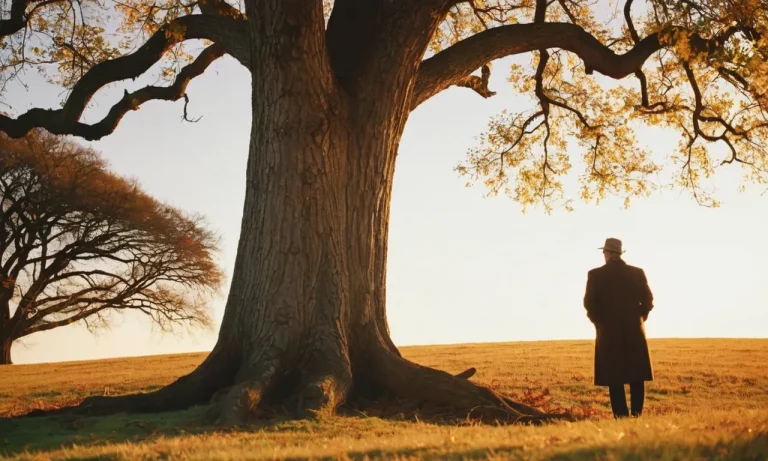Thorns have held symbolic meaning since ancient times, often representing hardship, grief, and physical suffering. If you’re wondering what spiritual meaning thorns may hold, read on.
If you’re short on time, here’s a quick answer: Thorns are most commonly understood as a symbol of sin, curses, and hardship in the Bible and other spiritual texts. They can represent the difficulties and painful trials of life that test our faith and character.
Thorns as Symbols in the Bible
The Curse of Adam and Eve
In the Book of Genesis, thorns first appear after Adam and Eve disobeyed God and ate the forbidden fruit. God curses the ground and declares in Genesis 3:18, “It will produce thorns and thistles for you.”
This imagery illustrates that thorns represent the consequences of sin – struggle, suffering, and hardship entered the world after the Fall.
The thorn imagery also foreshadows Christ’s later sacrifice. Just as thorns painfully pricked Adam and Eve’s feet, Christ’s feet would also be pierced by the nails on the cross. Yet while Adam and Eve’s actions brought a curse, Christ’s sacrifice brought blessing and redemption.
The Crown of Thorns of Jesus
In the New Testament, Christ wore a crown of thorns during his Passion. As told in Matthew 27:27-31, Mark 15:16-20, and John 19:2-5, Roman soldiers mocked Jesus as the “King of the Jews” by dressing him in royal purple, placing a staff in his hand, and crowning him with braided thorns before his Crucifixion.
This imagery ties back to the Genesis curse – the thorns originally meant to torment mankind now tormented their savior.
The crown of thorns symbolized Christ taking the sin and curse of Adam and Eve upon himself. Despite the torture, Jesus endured out of love for humanity. Just as thorns draw blood, Jesus shed his blood on the cross for the forgiveness of sins.
Thorns Representing Sin and Struggle
Several Biblical passages use thorn imagery to depict sin, anguish, and the trials of life:
- In Numbers 33:55, remaining Canaanites are compared to “thorns in your sides” showcasing how sin can torment the people of God.
- 2 Corinthians 12:7-9 mentions a “thorn in my flesh” allowed by God to keep Paul humble, emphasizing thorns as an instrument to sanctification despite causing suffering.
- Proverbs 26:9 compares talking to a fool as “sticking a thornbush in your hand” – just as literal thorns prick, foolishness brings unnecessary injury and pain.
Jesus’s parable of the sower in Matthew 13:1-23 also contains thorn imagery. Seeds falling among thorns represent those choked by “worries of this life and the deceitfulness of wealth” so no fruit is produced. Here thorns exemplify earthly desires that interfere with spiritual growth.
So in multiple contexts, the Bible utilizes thorns as metaphors for sin, anguish, and the brokenness of a fallen world. Yet the hope of Christ’s redemption shines through showing spiritual fruit can still grow even among life’s thorniest patches.
Thorns in Other Spiritual Traditions
Thorns in Buddhism
In Buddhism, thorns can represent suffering and attachment. The Buddha taught that life contains innate suffering, as clinging to desires inevitably leads to pain when those desires fade. Just as grasping a thorn bush brings pain, attachment leads to anguish and dissatisfaction.
The lotus flower is an important Buddhist symbol, as it emerges pure and beautiful from muddy waters. This represents the possibility of enlightenment, rising above worldly suffering. Notably, the lotus often grows amidst thorny underbrush along river banks.
This illustrates the Buddhist teaching that wisdom and compassion bloom when surrounded by hardship.
Thorns in Celtic Spirituality
Thorns feature prominently in Celtic spirituality, myth, and folklore. They represent hardship, challenge, suffering, and overcoming obstacles. One legend tells of a Celtic goddess named Rosemerta, who used her magical powers to transform thorns into red roses as a symbol of triumph over adversity.
Hawthorn trees with sharp thorns are sacred in Celtic tradition. Since they blossom in spring and early summer, they signify new beginnings and hope. At times, Celtic people would decorate holy wells and sites of worship with hawthorn branches, flowers, and wreaths as offerings to various gods and goddesses.
Interpreting the Spiritual Meaning of Thorns
Hardships that Test Us
Thorns have deep symbolic meaning in many faiths and represent hardships, difficulties, and challenges in life that test our resilience. Just as thorns prick and wound, life’s adversities and trials can cause us pain and distress.
Yet, thorns protect the rose, allowing the flower to bloom more beautifully. Similarly, overcoming thorns in life enables our soul to blossom.
Overcoming Pain and Adversity
The tenacity of thorns reminds us that we all have an indomitable spirit within, allowing us to endure life’s hurts and rise above difficulties. When we meet trials with courage and fortitude, we develop character and wisdom.
As Helen Keller insightfully said: “Character cannot be developed in ease and quiet. Only through experience of trial and suffering can the soul be strengthened, vision cleared, ambition inspired, and success achieved.”
Faith traditions often use the thorn metaphor to symbolize Christ’s suffering during crucifixion. Yet, the crown of thorns did not defeat Jesus’ spirit, just as hardships need not break ours. With faith and perseverance, we can transcend trials.
As the great prophet Isaiah declared: “When you pass through the waters, I will be with you.” (Isaiah 43:2)
Protecting Ourselves
While thorns test our mettle, we must also nurture wisdom to avoid needless wounds. Seeking inspiration through prayer or meditation helps fortify our minds against adversity’s sting. Building supportive communities, fostering understanding, and cultivating forgiveness can help minimize life’s hurts.
By learning from hard lessons, we gain insight to prevent repeat injury.
Most importantly, protecting the heart – the wellspring of life – enables our soul to weather misfortune while keeping passion and purpose intact. Though we cannot avoid missteps in life’s thorny terrain, we can walk with awareness, grace, and courage.
In this way, we traverse tribulations smoothly while delighting in the roses along our path.
Conclusion
While thorns may bring hardship and pain, their spiritual meaning goes deeper. They can represent life’s sharp trials that test our resilience and faith. By seeing thorns symbolically, we uncover hope in hardship, finding the inner strength to protect our hearts as we walk through difficulty into new life and growth.






